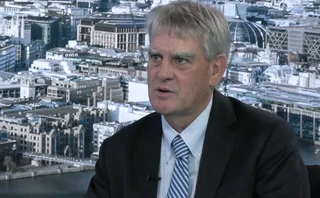
Exchange-traded funds house of the year: Commerzbank
Structured Products Asia Awards 2017: While exchange-traded funds are still not quite mainstream instruments in Asia-Pacific, Commerzbank has employed a smart approach to efficiently drive growth

When Commerzbank set out in 2011 to become the leading exchange-traded fund (ETF) market-maker in Asia, it knew it would have a tough job on its hands – the region had little experience of investing in listed funds and most exchanges had only a smattering of listings. Six years later, the task of creating a mainstream asset class remains a work in progress but Commerzbank is the runaway leader in trying to make it happen.
“It made sense that we should try to expand our leading European ETF market-making business and make it global, so we had a strategic rationale for coming to Asia, alongside an opportunity in a relatively untapped market,” says Antoine de Saint Vaulry, head of ETF and flow trading for Commerzbank Asia-Pacific. “Nobody was doing market-making as a standalone business, so we knew we had our work cut out. But we were up for the challenge.”
With just a four-man team based in Hong Kong, Commerzbank has made it its mission to convince Asian investors of the merits of transparent, low-cost listed funds, and has expended enormous effort in spreading the message through seminars, conferences and client meetings. One of the biggest challenges has been to convince investors that the funds are liquid enough to guarantee an easy exit.
“On a one-on-one comparison with listed stocks, ETF liquidity is lower, but of course if you compare the products with mutual funds the ETF is hugely more liquid. It’s a matter of communicating that and showing investors that they are not going to have a problem trading in and out,” says de Saint Vaulry. “It’s slow progress and we are not yet seeing massive volumes in Asia, but we are moving forward as people become more familiar.”
Commerzbank makes prices in Asia on around 3,000 global ETFs, and one of the challenges it faces is to quote prices on international ETFs where the relevant market in Europe or the US is closed. For less-liquid ETFs, for example fixed-income funds listed in the US, the bank is reluctant to carry risk through the Asian day as it waits for US markets to open. Its solution has been to trade based on a price that it will confirm once it knows the funds next day closing net asset value (NAV).
“Usually we can make a risk price based on current theoretical value – intraday NAV or iNAV – but if, for example, somebody comes in the Hong Kong morning for a US high-yield ETF, it’s a tough ask. In that case, we go back to the client and offer a price that they can trade on, but benchmarked to the NAV tonight,” says de Saint Vaulry. “That’s probably a preferable solution than taking a massive spread, which is the only realistic alternative if you are taking a big risk.”
The bank faces a similar challenge when it comes to hedging, which is straightforward where the underlying is traded in Asia hours but more challenging when it is located in Europe or the US. In those situations the Hong Kong team works closely with colleagues in Europe to trade proxy ETFs or stock index futures to manage risk.
“We are very close to our colleagues in Germany and we run a global book, usually taking an initial hedge through the futures market where that is available, and then refining later on,” says de Saint Vaulry. “We are optimising on a dynamic basis all the time and adjusting our hedge position continuously.”
ETF markets in Asia are developing at different paces, but key markets for Commerzbank include Hong Kong, Korea, Taiwan, Japan and Australia. Each has its own flavour and demand tends to reflect local investment preferences and priorities. In Korea that might mean there is higher-than-average appetite for riskier and leveraged positions, while in Taiwan local regulations allow institutions to take a much higher share of ETFs than they can in mutual funds.
The result is a number of ETFs in which the core shareholder holds as much as 90% of the stock. In Hong Kong, investor focus is on the RMB Qualified Institutional Investor (RQFII) initiative, which allows investors from outside the People’s Republic of China to hold mainland products. Meanwhile, demand in the Australian market has been shaped by new rules on how independent financial advisers are remunerated. “Previously, advisers were paid with rebates from product manufacturers, but now the system is based on assets under management. That has led to a rush for cheaper products, which has been great for ETFs,” says de Saint Vaulry. “In particular in the Australian market, we have seen rising demand for high dividend and smart beta strategies.”
One challenge in trying to move ETFs into the Asian investment mainstream is the regulatory landscape, which remains nationally focused and militates against a regional market-making strategy.
“As the market continues to develop, my wishlist would include an ecosystem and regulatory playing field that is a bit more unified,” says de Saint Vaulry. “At the moment you can build a nice business in Hong Kong, for instance, but there is no passporting or reciprocal arrangement, so that doesn’t mean you have a start in another Asian country. However, every year things are improving.”
Only users who have a paid subscription or are part of a corporate subscription are able to print or copy content.
To access these options, along with all other subscription benefits, please contact info@risk.net or view our subscription options here: http://subscriptions.risk.net/subscribe
You are currently unable to print this content. Please contact info@risk.net to find out more.
You are currently unable to copy this content. Please contact info@risk.net to find out more.
Copyright Infopro Digital Limited. All rights reserved.
As outlined in our terms and conditions, https://www.infopro-digital.com/terms-and-conditions/subscriptions/ (point 2.4), printing is limited to a single copy.
If you would like to purchase additional rights please email info@risk.net
Copyright Infopro Digital Limited. All rights reserved.
You may share this content using our article tools. As outlined in our terms and conditions, https://www.infopro-digital.com/terms-and-conditions/subscriptions/ (clause 2.4), an Authorised User may only make one copy of the materials for their own personal use. You must also comply with the restrictions in clause 2.5.
If you would like to purchase additional rights please email info@risk.net
More on Awards
Collateral management and optimisation product of the year: CloudMargin
Delivering the modern blueprint for enterprise collateral resilience
Flow market-maker of the year: Citadel Securities
Risk Awards 2026: No financing; no long-dated swaps? “No distractions,” says Esposito
Pricing and analytics: fixed income – Quantifi
Quantifi delivers high-performance, transparent and adaptable pricing and risk analytics for fixed income and credit markets
Derivatives house of the year: Citi
Risk Awards 2026: Rev up, RWAs down, as US bank gets back on track (with added XiNG and XiP)
Technology vendor of the year: SS&C Algorithmics
Risk Awards 2026: From cloud, to chips, to maths tricks – vendor getting more out of existing tech
SS&C Algorithmics: winner’s interview with Curt Burmeister
SS&C Algorithmics wins three categories in this year’s Markets Technology Awards in addition to Technology vendor of the year at the Risk Awards
Best vendor for system support and implementation: Murex
Murex wins Best vendor for system support and implementation at the Markets Technology Awards 2026
Pricing and analytics: cross-asset and structured – Murex
Murex wins Pricing and analytics: cross-asset and structured at the Markets Technology Awards 2026 thanks to its MX.3 platform







